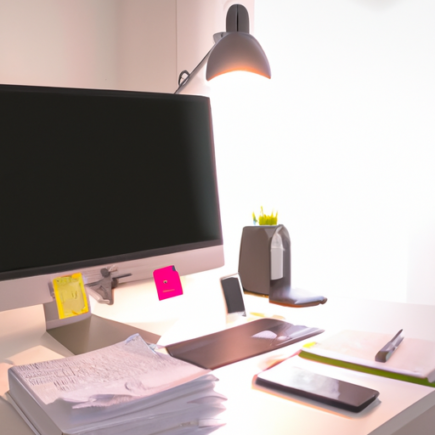in their designated places and maximize space utilization.
2. Establish a filing system: Implement a filing system that works for you. Categorize and label documents and folders to make it easier to find and access important information quickly. This will help reduce time wasted searching for misplaced documents and increase productivity.
3. Regularly clean and disinfect: Create a cleaning routine to regularly sanitize your workspace. Wipe down surfaces, keyboards, and phones to prevent the spread of germs and maintain a hygienic environment. A clean workspace not only promotes good health but also contributes to a positive mindset.
4. Utilize digital tools: Embrace technology to reduce paper clutter and streamline your workflow. Use digital files, cloud storage, and productivity apps to manage and store documents, collaborate with colleagues, and stay organized.
By implementing these practical tips, you can create a clean and organized workspace that promotes productivity and enhances your overall work experience. Remember, a clutter-free and well-organized environment allows for better focus, efficient task completion, and a more enjoyable work environment.
– The Connection Between a Clean Workspace and Mental Well-being
Having a clean and organized workspace goes beyond just physical benefits; it also has a significant impact on your mental well-being. A cluttered and messy workspace can create feelings of overwhelm, stress, and anxiety, making it difficult to focus and be productive. On the other hand, a clean and organized workspace can provide a sense of calmness, control, and motivation.
Studies have shown that a neat and tidy environment can reduce cortisol levels, the hormone associated with stress, and increase the production of serotonin, the hormone responsible for happiness and well-being. By eliminating clutter and keeping your workspace clean, you create a more peaceful and positive atmosphere that allows for better concentration and creativity.
In addition, an organized workspace helps reduce decision fatigue. When your desk is cluttered with multiple tasks and unfinished projects, it can be overwhelming and mentally draining. By decluttering your workspace and implementing organizational systems, you reduce the mental load and free up cognitive resources to focus on the task at hand.
Furthermore, a clean workspace promotes a sense of professionalism and pride. When clients or colleagues visit your office, a clutter-free and tidy environment conveys a positive impression and builds trust and credibility. Additionally, an organized workspace helps you stay on top of deadlines, appointments, and important tasks, which can reduce stress and enhance productivity.
To maintain a clean and organized workspace and improve your mental well-being, incorporate cleaning and decluttering into your daily routine. Set aside a few minutes each day to tidy up your desk, put away items, and organize your workspace. Prioritize tasks and create a schedule to manage your workload effectively and avoid feeling overwhelmed. By making these small efforts, you create a harmonious connection between your physical and mental space, leading to improved focus, creativity, and overall well-being.
– How to Encourage Cleanliness and Organization in the Office
Creating a clean and organized office environment requires not only individual efforts but also a collective commitment from everyone in the workplace. Promoting cleanliness and organization in the office can lead to improved productivity, reduced stress, and a more positive work culture. Here are some strategies to encourage cleanliness and organization in the office:
1. Lead by example: Practice what you preach and maintain a clean and organized workspace yourself. When others see your commitment to cleanliness and organization, they are more likely to follow suit.
2. Establish clear expectations: Set clear guidelines and expectations for cleanliness and organization in the office. Communicate the importance of maintaining a clean workspace and establish protocols for cleaning and organizing shared spaces.
3. Provide necessary resources: Ensure that the office is equipped with the necessary resources for maintaining cleanliness and organization. This includes cleaning supplies, storage solutions, and labeling tools.
4. Conduct regular clean-ups: Schedule regular clean-up days or initiatives where employees come together to declutter and organize the office. This can foster a sense of teamwork, accountability, and shared responsibility.
5. Offer training and education: Provide training and educational materials on effective cleaning and organization techniques. This can help employees develop the necessary skills and knowledge to maintain a clean and organized workspace.
6. Recognize and reward cleanliness: Implement a recognition or reward system to acknowledge employees who consistently maintain a clean and organized workspace. This can encourage and motivate others to follow suit.
By incorporating these strategies, you can create a workplace culture that prioritizes cleanliness and organization. A clean and organized office not only enhances productivity but also fosters a positive work environment, boosts employee morale, and promotes overall well-being.












